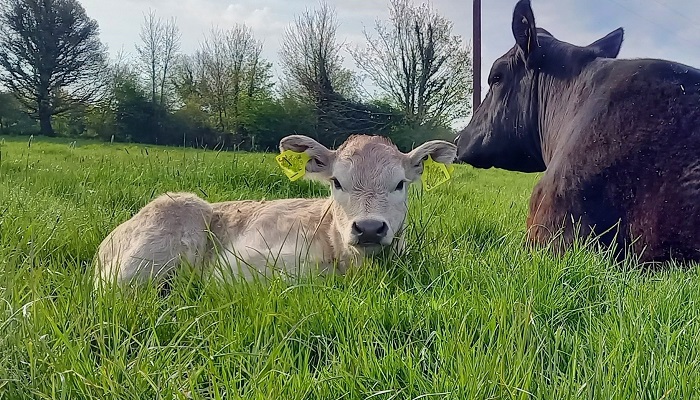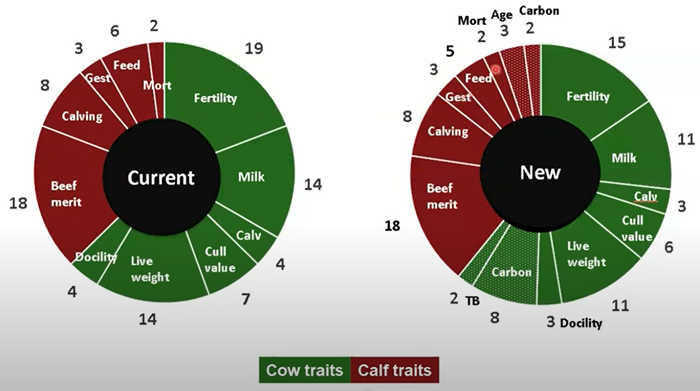15 November 2023
Chasing cost reductions through breeding – the role of the updated Replacement Index

An updated Replacement Index will be published on November 28. Within the improved breeding tool, there is a strong focus placed on reducing the costs associated with the keeping of suckler cows and the carbon emissions from both the cow and her resulting progeny.
Paul Crosson, Beef Enterprise Leader at Teagasc, Animal & Grassland Research and Innovation Centre, Grange, provided an insight as to why the Economic Values encompassed within the Replacement Index have changed, while providing some clarity on the inclusion of carbon within the index.
He explained: “The objective of breeding indexes is to create a tool for selecting more profitable animals that combine the animal’s genetic potential across a range of traits and economic values for those traits.
“The Terminal and Replacement indexes had previously been updated in 2015, before the introduction of the Beef Data and Genomics Programme, but substantial increases in prices and costs have occurred in the intervening period, while the systems have also evolved. Along with these changes, environmental criteria have become more important, as there is an urgent need to reduce greenhouse gas emissions,” he said.
Cost evolution and carbon
The Economic Values contained within the Replacement Index are garnered from a ‘blueprint’ or ‘baseline’ herd, which is spring-calving and has an average calving date of March 12th. The heifer progeny from this herd are slaughtered at 19 months at a carcass weight of 311kg; the male progeny are finished as steers at 22 months, generating 390kg carcasses.
Since the previous update to the breeding indexes occurred in 2015, significant cost and price evolution has occurred. Factors impacting the Economic Values included in the Replacement Index are: 13% higher beef prices; a 27% increase in the cost of concentrates; a 10% rise in the cost of nitrogen on a per unit basis; and a 38% increase in land rental costs.
Additionally, forage costs associated with a spring-calving system have also risen between 2015 and 2023; grazed grass costs have increased by 11%, while silage costs are up 20%. These price increases have been included into the Economic Values contained within the Replacement Index to be more representative of conditions at farm level.
Paul explained: “We really need to aggressively chase cost reductions within the suckler herd. Feed accounts for 75% of our total costs, so we need to chase feed costs in particular. Of course there are management aspects, but genetics is a really important component of that.
“If we look at the National Farm Survey data on suckler farms, the last time we updated the indexes the cost per suckler cow unit was just shy of €1,100. In 2022, the most recent year, that cost was about €1,550, so we have seen a rapid increase in costs.
“Farmers have experienced this cost increase – whether it be through fertiliser, feed or contractor costs – and we have translated that in terms of the updates and objectives if this revision of the cow traits; we want to reduce the cost of feeding cows.”
Additionally, Paul noted, improvements in cow fertility are also targeted. He commented: “Fertility also serves an important function. Where we have impaired fertility, cows calve later in a spring-calving herd. These later-calving cows tend to be indoors for longer on grass silage rather than outside on grazed pasture when compared to their comrades.”
Along with managing costs, the revised Replacement Index will also account for factors to optimise the value of output generated, with a focus placed on the calving interval to improve the number of calves produced annually.
“We need to bear in mind that fertility is a really important aspect of high levels of output on suckler beef farms. Where you have a 390-day calving interval, which is the national average, you are producing less than one weanlings per year on average. You are diluting your output on an annual basis,” Paul said.
Furthermore, carbon traits have also been included within some of the individual traits within the Replacement Index. Where these traits have a negative impact on greenhouse gas emissions, they are accounted for as a negative value or cost, thus promoting the production of more carbon efficient animals. Carbon traits have already been introduced to the Economic Breeding Index (EBI) and Dairy Beef Index (DBI).
On the inclusion of carbon, Paul said: “Within the Economic Value changes, only 13% of the Economic Values are due to carbon. It is moving us in the right direction, but it is certainly very much the minor player in terms of the changes that have occurred in the Economic Values. In other words, almost 90% of the changes in the Economic Values are due to conventional economics – the cost of fertiliser, the cost of contractor, the cost of feed – all of those costs that we feel on a day-to-day basis. That’s the main driver of change in the Economic Values.”
Key changes
The soon to be released Replacement Index, Paul explained, will comprise of 10 individual traits relevant to the cow or the cow’s own traits, with each given a weighing within the overall index to generate the Replacement Index euro value for each cow or replacement heifer. These traits are: age at first calving; maternal calving difficulty; maternal weaning weight; calving interval; survival; heifer feed intake; cow feed intake; cow docility; cull cow weight; and TB, which is a new addition to the index. Based on new prices and changes to the ‘blueprint’ herd, all of these traits will have an updated Economic Value.
In addition, due to the inclusion of new traits such as carbon, age of slaughter and TB, the relative emphasis of the Replacement Index is also set to change. Cow traits represented 62% of the relative emphasis of the previous index; this has now reduced slightly to 59%. Meanwhile, in terms of the traits pertinent to the calf, these traits – such as beef merit and calving to name just two – will represent 41% of the updated Replacement Index – up slightly in the Replacement Index in play from 2015 to November 2023.
Figure 1: Relative emphasis of the Replacement Index

Paul recently presented the changes to the Replacement Index as part of a Teagasc/ICBF webinar. Watch a recording of Paul’s presentation below for more details on how these changes were generated and what elements are targeted:
Also read: The Terminal and the Replacement Beef Index changes explained
